
Search
The Renewable Energy site for Do-It-Yourselfers
Sizing and Estimating Payback for a DIY Solar Water Heating System Using RETScreen
|
<--- NOTE NEEDS WORK you might want to convert this into how the RETScreen method works, or how to use RETScreen on your system >
This section shows you how to size your DIY solar water heating system to acheive the level of performance you want in your climate. It provides solar fraction, cost, payback and emissions reduction for systems ranging in collector size from 20 to 120 square feet for a variety of US climates.
Main uses of this material:
- To determine what size system is right for your climate
- To determine what that system will cost and what it will save and what its payback period is
- To determine how much your system will reduce CO2 emissions
The RETScreen energy modeling system is used to make these estimates. The RETScreen software from Natural Resources Canada provides energy modeling for a variety of renewable energy systems, including solar water heating. RETScreen is widely used, respected, free and it is setup to be used anywhere in the world. A copy of the model for our DIY system is provided so that you can custimize it to your needs and use RETScreen to do your own design studies. A copy of the model for our DIY system is provided so that you can custimize it to your needs and use RETScreen to do your own design studies.
|
|
Contents
- The RETScreen energy modeler
- Estimating DIY Solar Water Heater Performance across the US
- Solar water heating design trades with RETScreen
- Doing your own modeling with RETScreen
Building the RETScreen Model for the DIY Solar Water Heating System
The RETScreen model was built based on our $2K solar water heating design. The system modeled for RETScreen is basically the $2K system with the space heating part removed and the collector and tank resized for just the solar water heating role. This design is a very simple drain back system that uses a large, non-pressurized water tank to store solar heated water. In the collector loop, water is pumped from the tank, through the collector, and back to the tank -- no heat exchanger is used. Cold water on its way to the backup water heater is heated via a single pass through a large pipe coil heat exchanger that immersed in the solar heated water tank.
The $2K system is based on the $1K system with a few design refinements -- the estimates below are valid for either system.
If the system design you plan to use is different, you may have to make some changes to the RETScreen model.
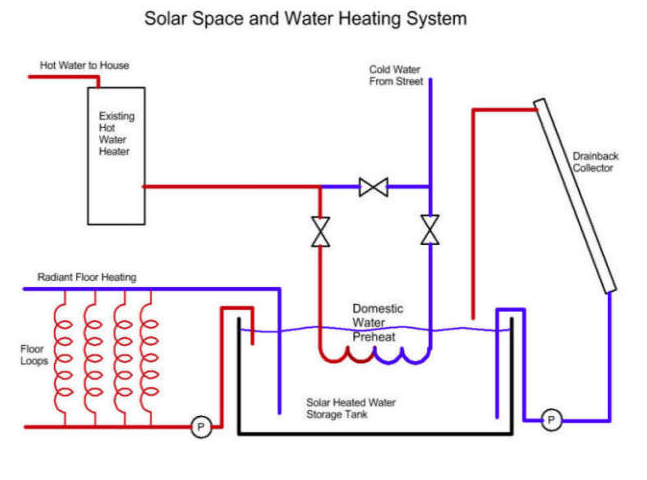
In a nutshell, the inputs for the RETScreen model are based on these assumptions:
- Hot water demand is 48 gal per day which is typical for a family of three
- Collector efficiency curve parameters are based on the SRCC efficiency curve for a commercial flat plate collector with a black painted (non-selective) absorber.
- Collector tilt is set to the latitude of each city modeled
- Cost is based on this cost table for the $2K system with the space heating left out. The cost is adjusted up or down depending on the collector and tank size used.
- The existing water heating (before solar) is assumed to be electric at 12 cents per KWH.
For each city/climate, a range of collector and tank sizes are analyzed so that you can see the variation in solar fraction, cost, energy saved, and CO2 emissions reduction for your climate for a wide range of system sizes.
Collector sizes ranging from 20 sf up to 140 sf are looked at for each of 15 US cities representing a wide range of climates. The tank sizes are all done as 2.5 gallons per sqft of collector area -- e.g. a 40 sf collector system gets a 100 gallon tank.
Setting the collector performance equal to a commercial collector with a black painted absorber seems about right to me. The absorber on the commercial collector might be a little more efficient due to its construction, but the $2K collector is double glazed and that should be good for a significant gain. The small panel collector tests also support this assumption.
This page gives the details on the inputs and assumptions made for the RETScreen model we used of our system. <-- link
Estimating DIY Solar Water Heater Performance across the US
The plots below show how the DIY solar water heating system does for 15 cities/climates that cover a wide range -- from the best solar climates to the worst.
For each city, systems ranging in size for 20 sf of collector to 140 sf of collector are covered. The Solar Fraction, cost, energy saved, and CO2 emissions are shown.
For people outside the US, you can try to pick pick one of the provided US climates that is similar to yours, or you can use the included RETScreen model and plug in your location -- RETScreen includes a climate database that covers most of the world.
Baseline Energy Use Before Solar
First, this plot just below shows the energy used and energy cost for a conventional electric water heater system. This plot assumes 48 gallons of water per day are heated to 120F in a 90% efficient electric water heateer using 12 cents per KWH electricity.
Since all of these systems heat 48 gallons a day of 120F water a day, and you might wonder why the energy required is not the same for all the cities. The reason is that the ground water temperature varies quite a bit -- getting down below 40F in the winter in some cold climates up to as high as 80F in the summer in some warm climates. The colder the ground water temperature, the more energy required to heat it.
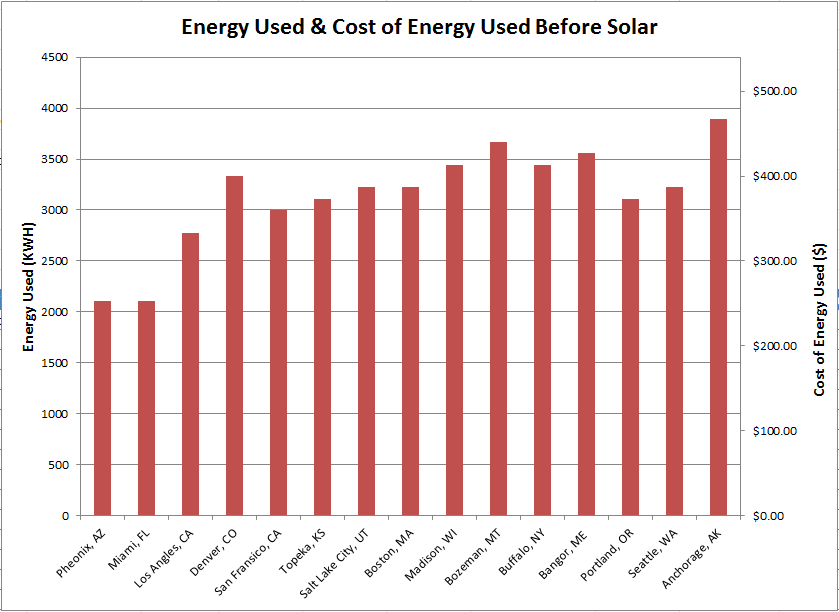
Of course, if you use more or less hot water, or you pay more or less for fuel to heat it, your costs will be somewhat different. You can use the provided RETScreen model to enter your actual data.
Solar Fraction
This plot shows how the Solar Fraction for the system goes up as the collector area goes up for each of the 9 cities/climates. Solar Fraction is the percentage of energy used to heat your water than comes from solar. An 80% solar fraction means a nearly 80% reduction in the cost to heat your water.
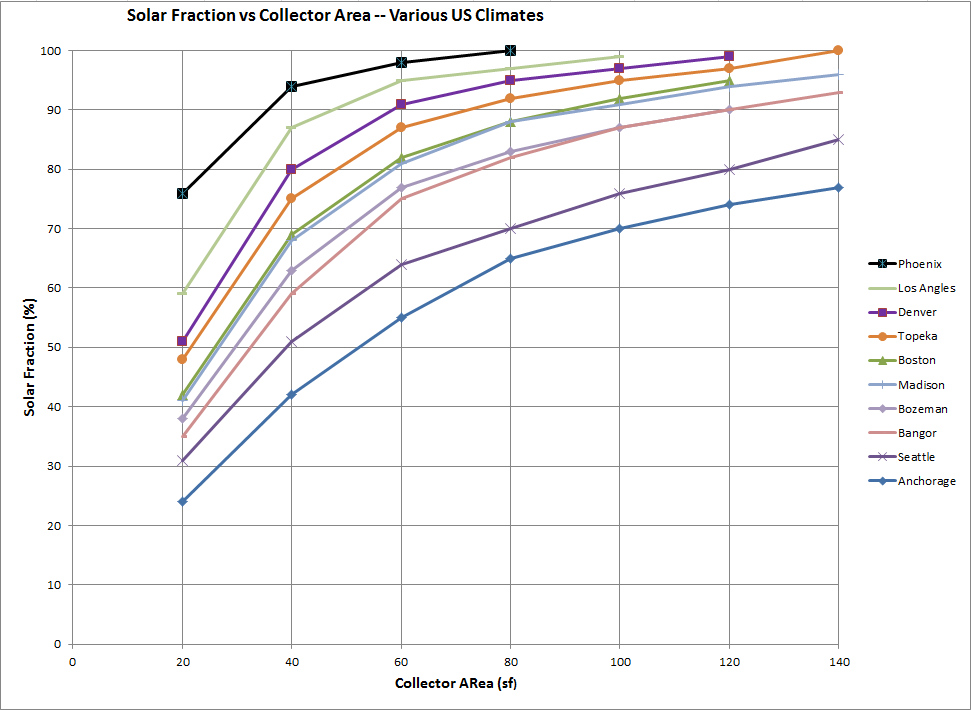
So, the collector size needed to achieve an 80% solar fraction ranges from about 24 sf in Pheonix to 120 sf in Seattle and even more in Anchorage.
The cities represent a range of climates from the worst to the best for solar water heating.
Seattle and Anchorage are the most challenging for solar water heating. Anchorage combines a fairly cloudy and cold climate with short winter days. Seattle has sunny summers, but difficult long cloudy winters. But even these difficult cities can achieve descent solar fractions with somewhat larger collectors.
On the other end of the spectrum, the Phoenix climate combines mild to hot temperatures and lots of sunshine and can achieve high solar fractions with small collectors.
Denver and Topeka are climates with coldish winters, but quite a bit of sunshine summer and winter. Probably typical of a lot of the Rockies and east into the plains.
Los Angless -- sunny sourthern Calfornia -- easy to get high solar fractions
Madison, WI, Bangor ME, Bozeman, MT, and Boston, MA are not what people think of as ideal climates for solar hot water with cold and somewhat cloudy winters, but, as the plot shows, high solar fractions can be achieved with moderate collector areas.
To get an idea what size system you want to build, pick one of the cities with a climate similar to yours. If you know what solar fraction you want to shoot for, just read the plot for the required collector area. If you want to see how much trying to achieve a higher solar fraction will save you in energy dollars and will cost you in initial investment and longer payback period, use the plot above in conjuction with the plots below on cost, payback, and savings to find a system that meets your goals. Of course, other factors like having a limited amount of space for collectors etc. may also limit your choices.
While it generally takes a larger collector to get a high solar fraction in colder northern climates, the energy saving for a given solar fraction in cold climates is higher because the ground water temperatures are lower. For example, the energy savings for the same solar fraction in Bangor, ME are 1.7 times more than the energy saving for the same solar fraction in Phoenix or Miami. <--- Note -- its not just the ground temperature -- climate (sunnyness) also figures in >
Payback Period
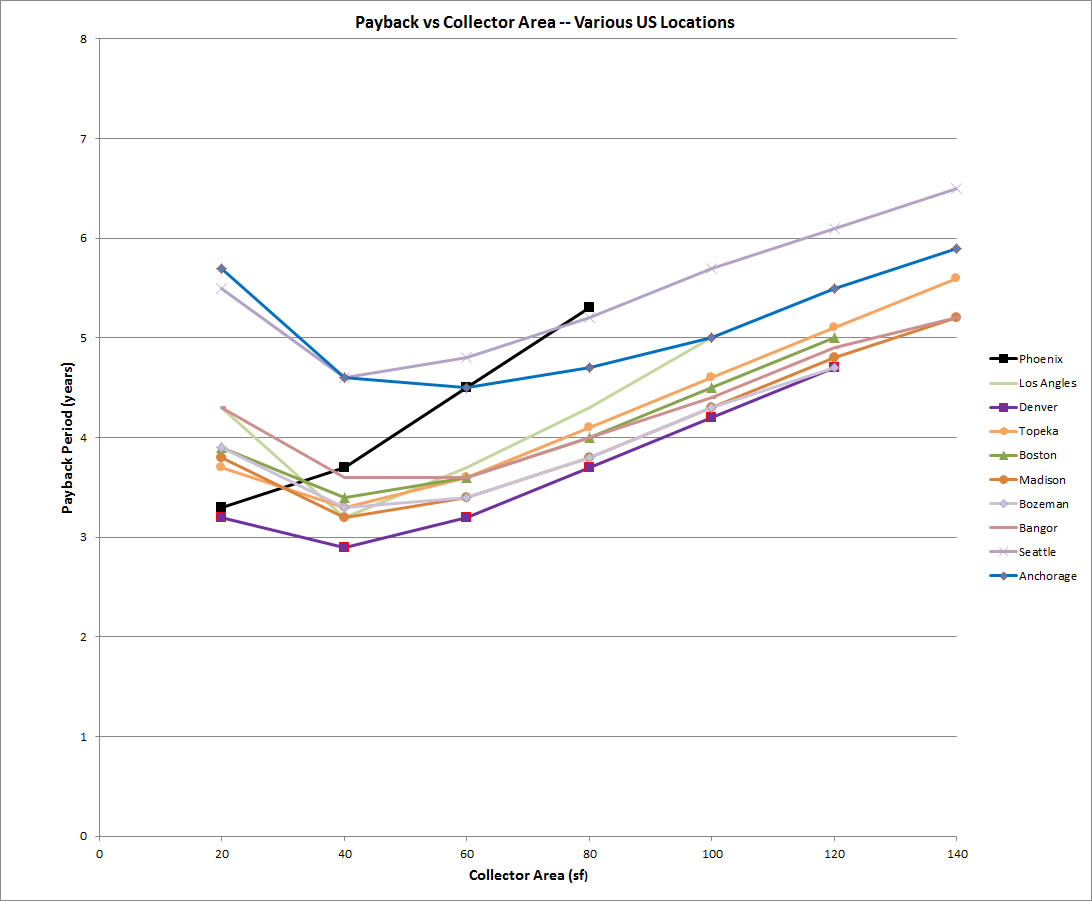
Energy saved
Cost saving
Payback
IRR
You want something that makes it easy to see that you should not necessarily build the system with the shortest payback time, but instead evalute what happens as you go beyond the minium payback period making the system larger -- as the collecto gets larger, each added sf of collector saves some additional energy and money -- you want to stop when that additional savings is not large enough to justify the additional cost o
Initial Cost of System
This plot shows the estimated cost of materials to build the system.
It is based on the costs for the $2K system. The collector is costed at $8.50 per sqft, tank at $1.80 per gallon, plus $426 of fixed costs for controller, pump, and plumbing.
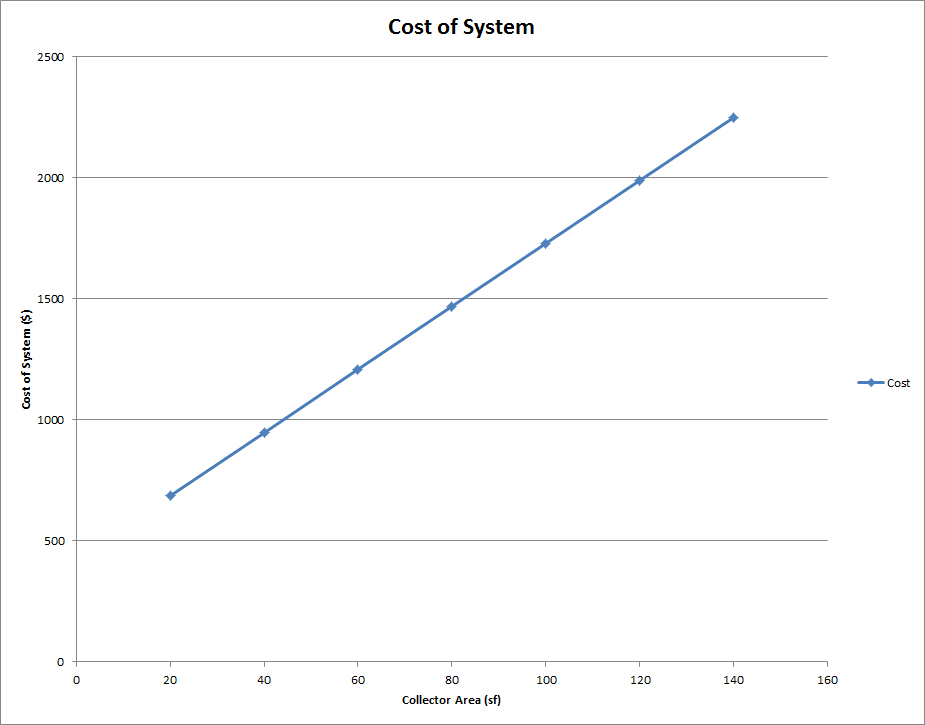

 A copy of the model for our DIY system is provided so that you can custimize it to your needs and use RETScreen to do your own design studies.
A copy of the model for our DIY system is provided so that you can custimize it to your needs and use RETScreen to do your own design studies.



